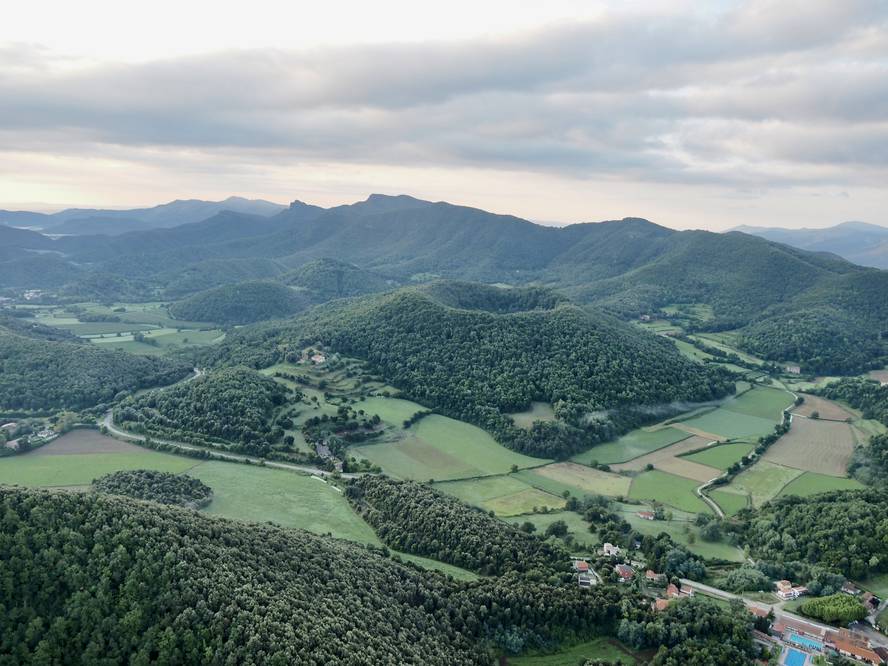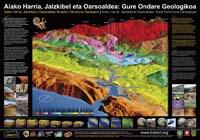In search of the traces of Earth's climate evolution
2023/05/22 Naroa Martínez Braceras - EHUko Geologia Departamentuko ikerlari doktorea Iturria: Elhuyar aldizkaria
To be able to make firm predictions about the climate change taking place on Earth, it is essential to know the evolution of the climate throughout history. The geological record forming rocks allows us to analyze how the climate has changed for millions of years. In our environment there are geological sequences that have contributed to the knowledge of some global climate phenomena.
Tackling climate change is one of today’s major challenges. Scientists have built several climate models to predict the evolution of climate conditions as a result of global warming. The future announced does not look good. If greenhouse gas emission rates do not decrease significantly, the global average temperature is expected to rise between 1.5 and 2 °C in the coming decades. In this regard, experts predict a number of harmful effects such as increased desertification, intensified rainy times, rising sea levels and the disappearance of certain living beings. Global news has shown that some of these conclusions are on the way. But how do we predict the impact of this warming on the dynamics of Earth's climate? To build the climate scenario of the future, it is essential to immerse ourselves in the climatic history of our planet to analyze the influence of the previous extreme climate episodes.
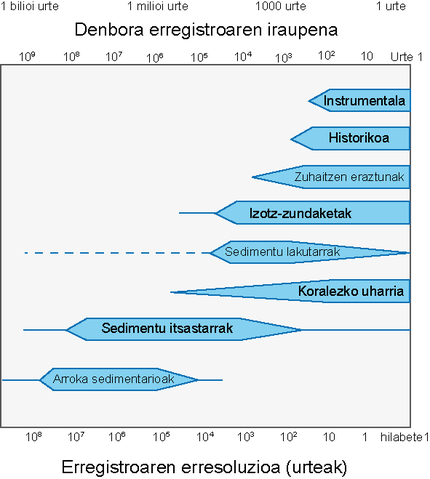
Although we have instrumental records of some climate parameters that reach the 19th century, the billions of years of the Earth remain in nothing. So how can we go back in time to know what the climate of the ancient Earth was like? Paleoclimatology is based on this. Paleoclimatologists investigate what a very old climate was like, its origin and its consequences, analyzing natural files such as ice polls, lake and sea sediments and sedimentary rocks. The physical, chemical and biological characteristics shown in these records help solve the climatic conditions of different times. There is no record covering the paleoclimatic evolution of all geological history. The integration of paleoclimatic signals from different backgrounds has allowed us to deepen the climate history of the Earth. Each file has its own characteristics and depending on the age range and resolution with which one wishes to investigate, one or other materials are selected. For example, although ice surveys provide very reliable and accurate records, they only allow study in the last millions of years.
Numerous paleoclimatic studies related to current climate change have focused on the last 2.59 million years of Earth's history, the Quarternary period. At this time, there were, among others, well-known glaciations. However, according to climate model predictions, rapid present and future warming has no parallel in the near past. If current gas emissions are maintained, the climate in 2150 is expected to be similar to the Eocene era (56 million years ago). During the eocene, the average surface temperature recorded a maximum, 13 ° C warmer than the current one. The concentrations and temperatures of the greenhouse gases were so high that the ice of the poles disappeared. These warm times on planet Earth associated with high concentrations of greenhouse gases are called greenhouse. Eocene has been the last greenhouse period in Earth's history, but in older times, like half the Cretaceous (95 million years ago), conditions were similar. In these warm times, in addition to being warm in the general climate, there were climatic episodes associated with rapid and abrupt temperatures that could be analogous to the current climate change. As an example, the maximum heat that started the Eocene period (PETM: Paleocene-Eocene Thermal Maximum) or Cretaceous Middle Ocean Episodes (EEO: Oceanic Anoxic Event).
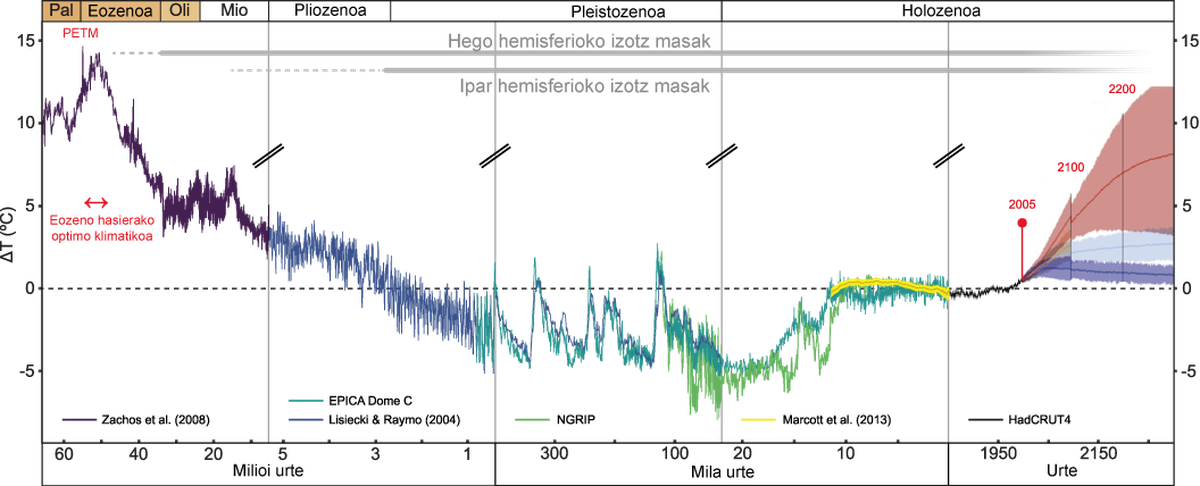
Apparently, paleoclimatic sequences that exceed tens of millions of years are particularly interesting. Paleoclimatic records of these ages have been frequently analyzed in sedimentary series. Sediments are solid particles that form, transport and accumulate as a result of processes and phenomena affecting the atmosphere, the hydrosphere and the biosphere. They are often deposited in so-called bodies of water containing mineralized remains (shells, skeletal pieces, etc.). of the organisms that inhabit them. The physical composition (grain size, sedimentary structures...), chemistry (stable isotopes, mineral content, chemical composition..) and the fossil content reflect the climatic conditions of the environment. Finding sediments of tens of millions of years is not easy. In addition, in order to preserve the climate signal well, the records must show continuous and constant sedimentation, without influence of the intense tectonic activity that distorts it.
On the right track, the aforementioned conditions can be found in calm bodies of water, lakes and open sea. It is to be assumed that marine sediments that accumulate hundreds or thousands of meters deep can talk little about the climatic conditions of the earth’s surface. However, some of the sediments accumulated in the deep sea originate in the continent, either transported by wind or adults by water streams. Another part, often the main one, will have a marine origin. The most important fraction of marine origin consists of microscopic mineralized shells and skeletons of the organisms they inhabit. These living creatures also depend on the physical-chemical conditions of the ocean surface produced by the climate, so they are sometimes able to record changes in the climate. In some sedimentary surveys carried out in the Gulf of Bizkaia, for example, the study of the physical and chemical characteristics of microscopic organisms and marine sediments has made it possible to observe the climate evolution of the last 140 thousand years.
Although sediments from the Gulf of Bizkaia have not allowed the study of very old ages, the investigation of submarine sediments has allowed the reconstruction of the paleoclimatic signal of 100 million years. In order to obtain longer and older records, hundreds of kilometers have had to be taken off the coast and submerged under a water column of other meters. Conducting multimeter surveys under these conditions requires very advanced technological support. As you can imagine, this infrastructure is not within the reach of all researchers. So if we can't study one of these ocean polls, isn't it possible to study the old paleoclima? Fortunately!
There is another more accessible type of registration that allows the study of minors: sedimentary rocks. Sedimentary rocks are hardened and compacted sediments until they become rocks. Sediments are transformed into rock due to the intergranular fluid movements that occur when the sediments are buried and the pressure exerted by the youngest sediments accumulating on them. Thanks to the tectonic uplift, today we can find in the earth's crust very old rocks formed at great depth in the subsoil. These rocks allow the study of records over 100 million years old, including the paleoclimatic file. In addition, rocks retain the drift of the continents suffered by planet Earth, tectonic activity, alien phenomena, extinctions and manifestations of living beings and the responses of many other geological aspects. Unfortunately, the older the rocks, the greater the influence of post-stacked processes that can transform the original climate signal of the rock. Therefore, rock sequences should be studied in depth, carefully selecting the samples and parameters to be analyzed.
In our region, from the tips of the mountains to the cliffs, sedimentary rocks predominate. These rocks are formed by materials accumulated in the sedimentary depression called the Cantabrian Basque Basin. A sedimentary record of approximately 250 to 35 million years accumulated in the basin. The tectonic efforts that led to the uprising of the Pyrenees have today allowed these sedimentary rocks to emerge. So to study the outcrops formed by ancient sediments, we will only spend a little bit of petrol and mountain boots.
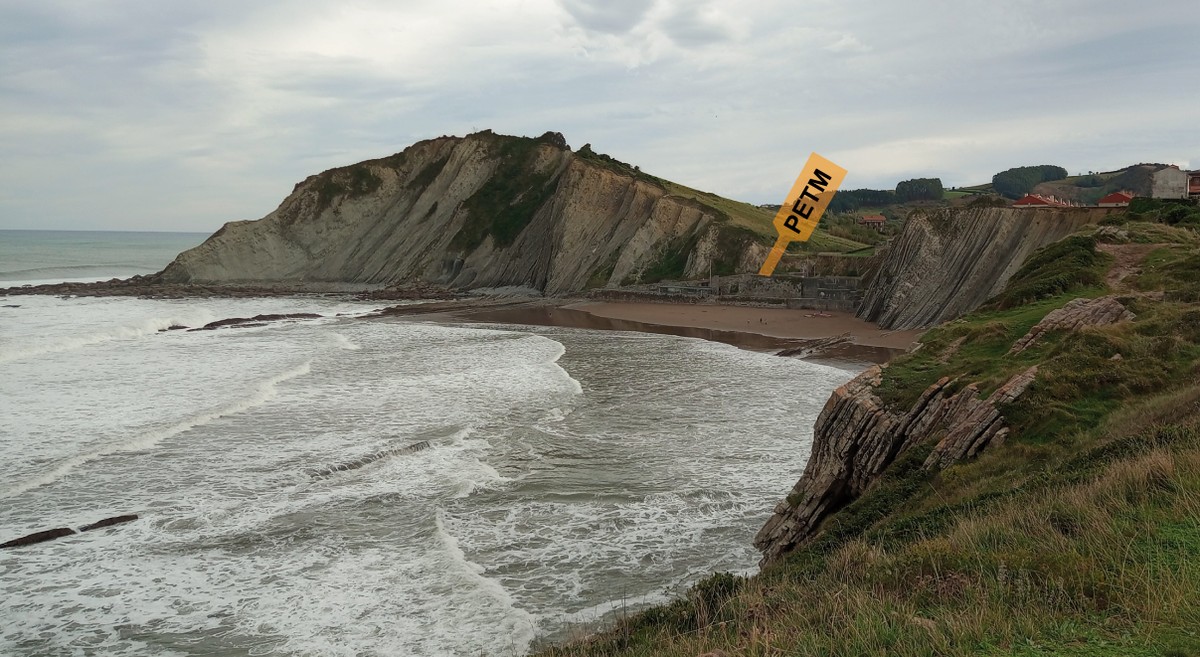
Numerous geological sequences have been found in the Cantábrico Vasco basin that are ideal for paleoclimatic studies that have been key to the knowledge of some climatic phenomena affecting the world. In some outcrops of our coast, rock sequences accumulated at deep sea can be found in the aforementioned greenhouse periods. Examples of this are the rock sequences that emerge in Considered Zumaia or in Uribe Kosta, which are characterized by being formed by thousands of layers of sheet piles and followed laterally. These layers are similar to the pages of the book that preserves the paleoclimatic history of the Earth and allow to know the evolution of the ancient climate through the reading of various physical, chemical and biological parameters contained therein. In Zumaia we have an excellent record of worldwide reference underwater METM that has attracted researchers from different countries. In Bizkaia, on the cliffs that range from Sopelana to Punta Galea, in addition to the partial records of PETM, other registers of weaker climate events have been identified worldwide in the Eocene, important to know the variability of the earth's climate. In addition, unique records of the central EFA of the Cretaceous have been found in the continental platforms of half depth of the Basque Basin, today in outcrops of Aralar, Pagasarri or Western Cantabria.
Bibliography
Burke, D.C., Williams, J.W., Chandler, M.A., Haywood, A.M. Lunt, D.J. and Edit-Bliesner, B.L. 2018. “Pliocene and Eocene provide best analogs for near-future climates.” Proceedings of the National Academy of Sciences, 115(52), 13288-13293.
Martínez–Braceras, N., Payros, A., Arostegi, J., and Dinarès–Turell, J. 2021. “Physical and geochemical record of an early Eocene carbon cycle perturbation on a turbiditic continental margin”. Sedimentology, 68(2), 881-904.
Millán, M. I. Weissert, H. J. Fernández-Mendiola, P. A, and García-Mondéjar, J. 2009. “Impact of Early Apan carbon cycle perturbations on evolution of a marine shelf system in the Trailers-Cantabrian Basin (Aralar, N Spain)”. Earth and Planetary Science Letters, 287(3-4), 392-401.
Pujalte, V., Baceta, J. I. and Schmitz, B. Climate of the Past,11(12), 1653-1672.
Rodríguez Lázaro, J., Pascual, A., Cacho, I., Varela, Z. and Pena, L. D. 2017. “Deep-sea benthic response to rapid climatic oscillations of the last glacial cycle in the SE Bay of Biscay”. Journal of Sea Research, 130, 49-72.
Ruddiman, W.F. 2008. Earth`s climate. Butcher W. H. Freeman and Company, New York.
Tierney, J. R. Poulsen, C. J. Montañez, I. P., Bhattachary, T., Feng, R., Ford, H. L. ... and Zhang, Y. G. 2020. “Pilot climates inform our future.” Science, 370(6517), eaay3701.

Gai honi buruzko eduki gehiago
Elhuyarrek garatutako teknologia




